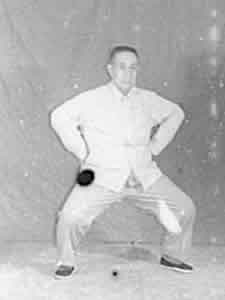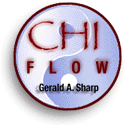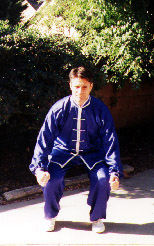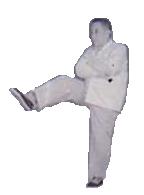|
Strong Roots Like in most Chi Kung practice, Wu Style's T'ai Chi Chi Kung provides the practitioner with advanced skills, that allow the practitioner to gather, dispel, direct, and store Chi (Vital Energy). It can be considered a moving meditation. The lack of complexity on the surface and a de-emphasis on working during practice (less complicated, more refined movements) and a focus on "following nature" casually develops the practitioner's Kung (Skill or talent). In the ancient philosophical aspects of training Kung (or, skill), which is still carried on today, there is a belief in developing a strong foundation from the ground up when practicing or learning anything; and Wu Style's T'ai Chi Chi Kung is no exception. However, Wu Style's simplicity and precision aid to free the practitioner to explore the simplicity of Chi on many levels without the emphasis on cumbersome or overly intricate movements which may lead to early levels of advance discovery, but "over the long haul" persistence in correct, precise, fluid movements ultimately lead many practitioners to the same place. Therefore, Wu Style T'ai Chi Chi Kung focuses on the essential and harnesses energy for maximum power and strength.
The simplicity of Wu Style's T'ai Chi Chi Kung opens the doors for the practitioner to incorporate the laws of motion and principles of Physical Science by following movements which encourage the flow of energy with Acu-Meridian therapy (utilized in traditional Chinese massage and acupuncture).
The practice of Wu Style T'ai Chi Chi Kung leads to high emphasis both as a practitioner of martial arts and a path of healing both within oneself and with others around them. The simplicity of movements as taught to me by my teacher, Ma Yueh Liang, led to dynamic understandings in the application fluidity and speed from T'ai Chi practice, and further helped me realize how all the Wu forms are interconnected and fit together like a puzzle. Moreover, how all the forms, including the refinements expressed in the Wu Style T'ai Chi Kung help the practitioner apply Wu Style (or, any style of martial arts) as an effective martial art in intercepting force, redirecting force, and striking with phenomenal amounts of speed and power.
At first glance, the practice appears extremely light, slow, and soft and the average onlooker might not see the potential for speed and power. However, it's because of the emphasis on lightness, that speed and power that is vital and precise is casually developed. Such training emphasizes accurately striking soft parts on the opponent with a deep foundation and force that potentially goes beyond what many practitioners have ever thought existed within themselves when first encountering benefits of T'ai Chi training.

Ma Yueh Liang practicing Zhanzhuang.
Although the movements themselves, help flow the chi along the appropriate channels, and actually require little or no thought whatsoever once the movements can be practiced with some degree of proficiency. However, that said, having knowledge of acu-meridian points and acu-meridian channels and therapy is very useful, as is basic knowledge of Western Medicine systems--at least knowledge of organ locations and functionality of organ systems. My teacher, Ma Yueh Liang was himself a Western trained medical doctor graduating from Peking Medical College in 1929 with a specialty in Hematology (the study of blood). Ma's knowledge and practice of T'ai Chi and Chi Kung influenced how he practiced and developed a lifetime of knowledge of Western medicine, and his studies of medicine certainly had a great influence on how he perceived and practiced the internal arts. He often referred directly to organs and how the organ systems influenced each other. Furthermore, he would elaborate on how chi could be directed to strengthen organs and bodily functions.
|
An East - West Connection  The practice of Wu Style's T'ai Chi Chi Kung leads to an emphasis both as a practitioner of martial arts and a path of healing both within oneself and with others around them. The simplicity of movements as taught to me by my teacher, Ma Yueh Liang, led to dynamic understandings in the application fluidity and speed from T'ai Chi practice, and further helped me realize how all the Wu forms are interconnected and fit together like a puzzle. Moreover, how all the forms, including the refinements expressed in the Wu Style T'ai Chi Kung help the practitioner apply Wu Style (or, any style of martial arts) as an effective martial art in intercepting force, redirecting force, and striking with phenomenal amounts of speed and power.
The practice of Wu Style's T'ai Chi Chi Kung leads to an emphasis both as a practitioner of martial arts and a path of healing both within oneself and with others around them. The simplicity of movements as taught to me by my teacher, Ma Yueh Liang, led to dynamic understandings in the application fluidity and speed from T'ai Chi practice, and further helped me realize how all the Wu forms are interconnected and fit together like a puzzle. Moreover, how all the forms, including the refinements expressed in the Wu Style T'ai Chi Kung help the practitioner apply Wu Style (or, any style of martial arts) as an effective martial art in intercepting force, redirecting force, and striking with phenomenal amounts of speed and power.
At first glance, the practice appears extremely light, slow, and soft and the average onlooker might not see the potential for speed and power. However, it's because of the emphasis on lightness, that speed and power that is vital and precise is casually developed. Such training emphasizes accurately striking soft parts on the opponent with a deep foundation and force that potentially goes beyond what many practitioners have ever thought existed within themselves when first encountering benefits of T'ai Chi training.
As a form of bodywork or in healing, the practitioner often begins with a focus on themself and those immediately around them. They may feel a greater ease of breathing, tingling, colors, sensation of water flowing through them, spark-like sounds, succession of bursts, and a feeling of letting go or overcoming that which oppresses them from within.
Over time the practitioner of Wu Style T'ai Chi Chi Kung, as well as other types of Chi Kung practice, is exposed to the healing and harmful points of practice. Both of these aspects of practice are issues in "passing on" or transmitting knowledge. All practitioners should be of good heart and realize that knowledge should be used correctly. This includes an evaluation that neither underestimates nor overestimates the potential health effects. A range of martial applications are available that should allow a level of restraint appropriate to the situation to be employed by the practitioner that has progressed through the system to the Wu Style T'ai Chi Chi Kung practice.
The Wu style EIGHT METHODS Chi Kung are grouped as follows:
- Gathering: Exercises 1-3
- Circulating: Exercises 4-5
- Guiding: Exercises 6-7
- Balancing: Exercise 8 (a,b,c)
- Spiraling: Exercises 9-10
- Blending: Exercise 11
- Synthesizing: Exercise 12
- Storing: Exercise 13
|
|
1. "Move the Chi Up and Down" (Like the Up and Down Hands) The First Form directs students to raise hands like T'ai Chi Ch'uan, but continue moving upward above the head. Then bringing the hands down, backs of the palms facing, all the way to the lower abdomen and repeating 3 more times for a total of four times. Then reversing for four more repetitions.

This movement encourages the stabilization of chi, dispelling of bad chi, and an opening of the lung channel; as well as a connection of the Du and Ren meridians
|
2. Monkey Offers Fruit Bring the backs of the hands towards the clavicles, and direct the palms outward. Then bring the palms to the front of the body, and repeat. After four repetitions, reverse and do four more repetitions.

This form is good for limbering the shoulders, and dispelling and gathering chi through the axilla (armpits). It also encourages the strengthening of the auxiliary nodes, stimulation of the heart, lung, small intestine, and stabilization of the axillary nerves.
|
|
3. Draw Wings Bring palms inward and facing up, and gradually change to claw hands ("Eagle's Beak"). The fingers on the claw hands face upward towards the axilla (armpit). After four repetitions, reverse and do four more repetitions.

This form is good for limbering the shoulders, gathering chi through the axilla, strengthening the auxiliary nodes and nerves. Negative effects of arthritis are momentary relieved, and dexterity of the fingers, hands, and connective tissue are encouraged. Yin and Yang Channels of the hands as well as the internal organs are stimulated by working the fingers repetitiously. This is a powerful form with specific, fine motor benefits.
|
4. Blend the Internal and External Chi The hands at first come down as if closing up T'ai Chi. Store the chi thus far generated outside of you down into the Lower Abdomen (Lower Dantian). Then continue circling the arms upward gathering Yang chi. Circle arms up over head then bring down storing chi down into the Lower Dantian. After four repetitions, reverse and do four more repetitions.

This form is good for strengthening the axillary nodes and nerves. The large arm and shoulder motion works the humerus articulation and expands the scapula and connective tissue. This form is also a progression on the previous forms and encourages a blending of external and internal energies, and an absorption of chi through the armpits and a storing of the chi in the Lower Dantian, by the mere falling of the arms and armpits as the arms are guided downward in both directions.
|
|
5. Bend Forward and Circulate the Chi From the previous form, bend at the waist, and continue circling the hands down in front of you. Once at the ground level, cross the left over the right, stand up slowly, and bring the arms up over head. Separate the arms and circle outward and repeat. After four repetitions, reverse and do four more repetitions.

This form continues the progression begun by previous forms. That is that the axillary functions, as well absorbing chi through the axilla continues but on a deeper level. The bending of the waist helps open the Mingmen (Life Gate point located at the center of the small of the back) and absorb Yang Chi. The bending of the waist with the legs straight (or nearly straight for problem back), stimulates the bladder channel and kidneys. The bending of the waist also helps encourage the storing of chi in the Lower Dantian, as well as help bring a flow of chi up the back along the Du Channel, and as one stands up a dropping of the chi down the Ren Channel. Thereby encouraging the microcosmic orbit (Small orbit, or pulmonary circulation) of chi.
|
6. Remove the Helmet After the last repetition from the previous form, stand, and bring the hands to the front. Then bring the hands straight back (gradually crossing the right over the left and over the head. At the top of the head at the Baihui (Hundred Convergences) point, separate the hands and guide the chi outwardly. After four repetitions reverse and bring the hands inward with the left over the right, and pass upward over the Fengzhi point over the head and Baihui point, and push palms to the front. Again do four repetitions.

This form is good for opening the Baihui and storing chi. The first part of the form helps open the Baihui point, and the second gathers energy for storing. As the hands press forward and circle outward to gather energy in the reverse sequence, fresh energy is gathered and stored down ultimately in the Lower Dantian.
GO TO PAGE 2 OF Wu Style CHI KUNG
|














